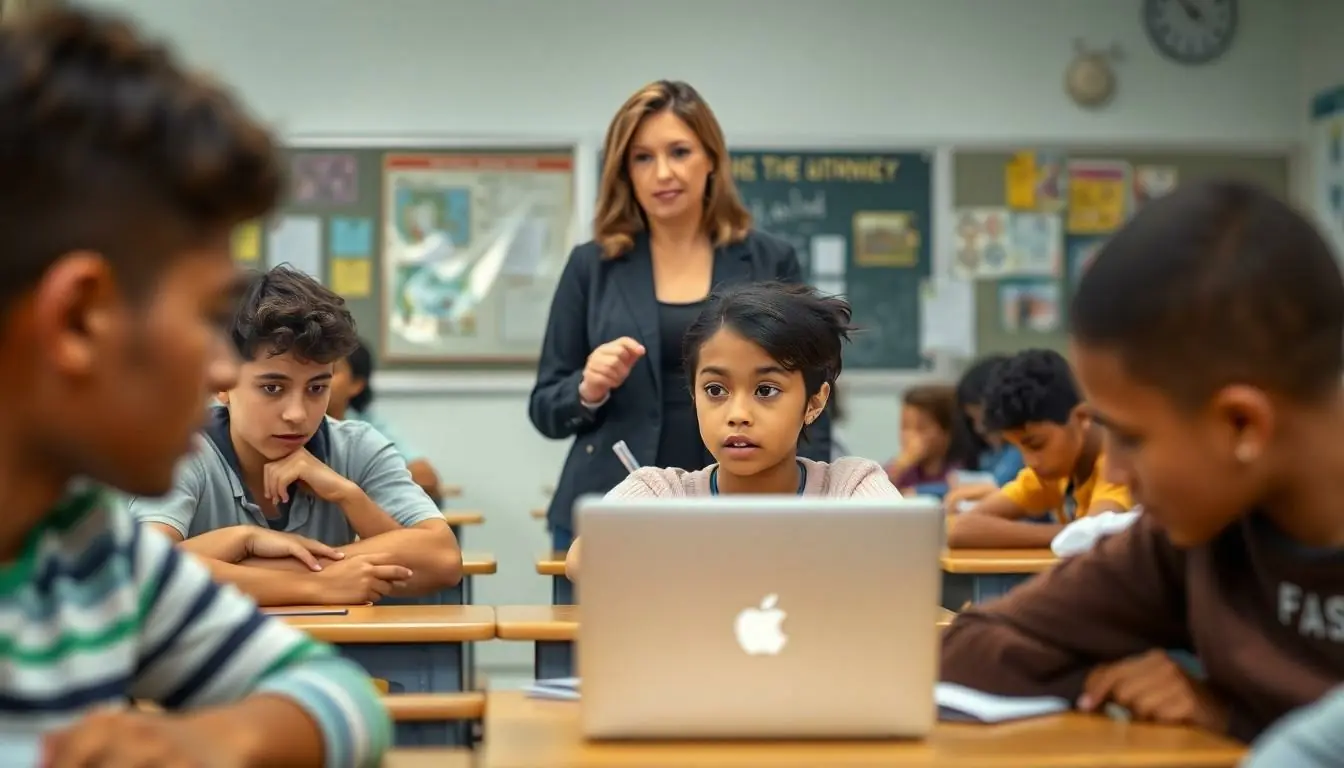Table of Contents
ToggleIn the age of technology, students have a secret weapon at their fingertips: ChatGPT. It’s like having a personal tutor who never sleeps and is always ready to help with homework. But as tempting as it is to tap into this AI genius, students might wonder: can teachers tell when they’ve had a little help from their digital friend?
Imagine the scene: a teacher’s gaze scanning the room, eyebrows raised, as they suspect a student might be channeling their inner chatbot. The truth is, while AI can whip up essays faster than a caffeine-fueled all-nighter, teachers are getting smarter too. With the right tools and a keen eye, they can spot the difference between a human touch and a robotic response. Buckle up as we dive into the intriguing world of AI-assisted learning and the cat-and-mouse game between students and teachers.
Understanding ChatGPT Usage
ChatGPT serves as a powerful tool for students seeking homework assistance. Teachers exhibit growing awareness of how students utilize AI to enhance their work. Some educators develop strategies to identify AI-generated responses, effectively narrowing the gap between technology use and academic integrity.
AI detection methods include specialized software designed to analyze writing styles. Various platforms assess patterns typical of AI-generated content, allowing teachers to differentiate between student work and machine-generated outputs. Activities like comparing submissions against a database of known AI texts enhance the detection process.
Understanding when students turn to ChatGPT involves examining writing coherence and originality. Work produced by AI often follows specific structures and lacks personal insight, making it distinguishable. Educators may notice stylistic mismatches when students use AI tools extensively, leading to potential discussions about academic integrity.
Regular discussions about the proper use of AI in education empower students to use ChatGPT responsibly. Strategies such as encouraging students to synthesize AI-generated information with personal insights promote balanced learning. Teachers can guide discussions that foster ethical technology usage while reinforcing the learning experience.
As the educational landscape evolves, collaboration between teachers and students becomes vital. Teachers adapt their approaches, enabling them to teach AI literacy. Collective understanding bridges the gap and ensures students appreciate the value of authentic work.
Teacher Awareness


Teachers increasingly recognize when students utilize AI tools like ChatGPT. They develop methods to identify signs of AI assistance and effectively address this challenge.
Indicators of AI Assistance
Educators look for specific characteristics that hint at AI usage. AI-generated texts often display a lack of coherence, leading to unusual vocabulary choices and sentence structures. Unnatural phrasing may appear where students typically express authentic thoughts. Additionally, educators may notice abrupt shifts in writing style or inconsistent voice throughout the assignment. These indicators help teachers distinguish between genuine student work and AI-produced content.
Behavioral Cues
Students exhibiting certain behavioral patterns may also raise teachers’ suspicions. Submitting work that dramatically deviates from their usual performance can trigger questions. Hesitation in discussing the specifics of their submissions may indicate deeper reliance on AI tools. Observing students during discussions provides further insights, revealing if they possess familiarity with the material or are merely repeating AI-generated information. Regular monitoring of these behaviors aids teachers in understanding and addressing reliance on AI assistance.
Technology’s Role
Technology plays a significant role in identifying AI-generated content in educational settings. As educators adapt to these advancements, they seek effective tools to detect instances of AI assistance.
Detection Tools and Software
Various software solutions analyze writing patterns to distinguish between human and AI-generated text. These tools utilize algorithms to assess syntax, vocabulary usage, and overall coherence. Some platforms compare student submissions against extensive databases of known AI outputs. Teachers also explore AI detection services that highlight anomalies in language, providing educators with insights into potential AI utilization. Such detection methods enhance teachers’ ability to identify reliance on AI tools effectively.
Limitations of Current Technology
Current detection technology faces specific challenges when identifying AI usage. Notably, sophisticated AI systems can generate highly coherent and original content. Significant variations among student writing styles may further complicate accurate assessments. Teachers might struggle to distinguish genuine student work from AI-generated responses due to these advancements. Additionally, detection tools often require updates to stay aligned with the evolving capabilities of AI. These limitations highlight the ongoing need for educators to develop strategies that complement technology in detecting AI assistance.
Ethical Considerations
Ethical considerations around AI usage in education encompass various dimensions. Schools must prioritize academic integrity and student privacy.
Academic Integrity
Maintaining academic integrity remains crucial in modern education. Using tools like ChatGPT can blur the lines between original thought and AI-generated content. Students must understand that relying heavily on AI tools could lead to academic dishonesty. Teachers encourage independent thinking while promoting responsible AI use. Discussions around ethical AI usage often emphasize creating a balance between leveraging technology and promoting creativity. Assignments that require personal insights help ensure students engage meaningfully with their work.
Student Privacy
Protecting student privacy is an essential ethical concern. AI tools often gather data for generating responses, which raises questions about the security of personal information. Teachers and administrators need to ensure compliance with privacy laws, including FERPA regulations. Conversations around data usage help students understand how their information may be processed. Students should be informed about the implications of using AI tools in their learning, allowing them to make educated choices. Emphasizing transparency fosters trust between students and educators regarding technology usage in the classroom.
Teachers are becoming increasingly skilled at recognizing when students use AI tools like ChatGPT. As they adopt advanced detection methods and remain vigilant about writing patterns and behavioral cues, the challenge of distinguishing between human and AI-generated work persists.
The importance of fostering a dialogue around responsible AI usage in education cannot be overstated. Encouraging students to blend AI assistance with their own insights promotes critical thinking and academic integrity.
As technology continues to evolve, so too must the strategies educators employ to maintain a balance between leveraging AI’s benefits and upholding the values of originality and ethical learning. Building a collaborative environment where students understand the implications of AI will ultimately lead to a more informed and responsible approach to technology in education.







